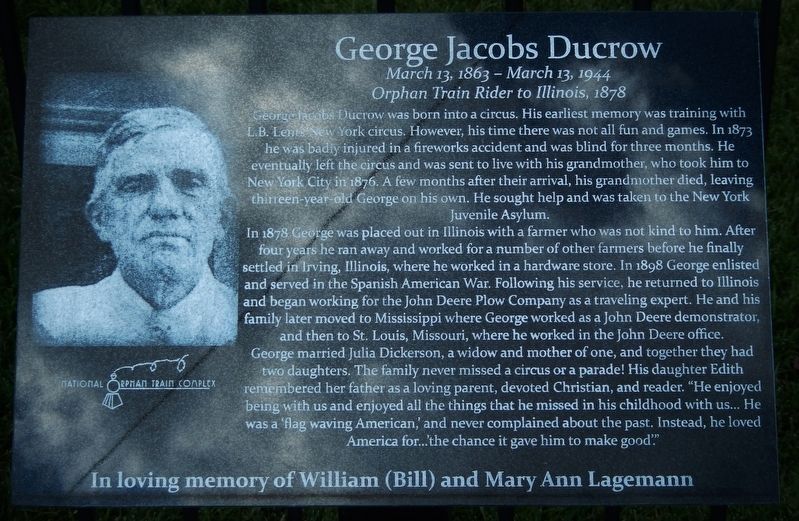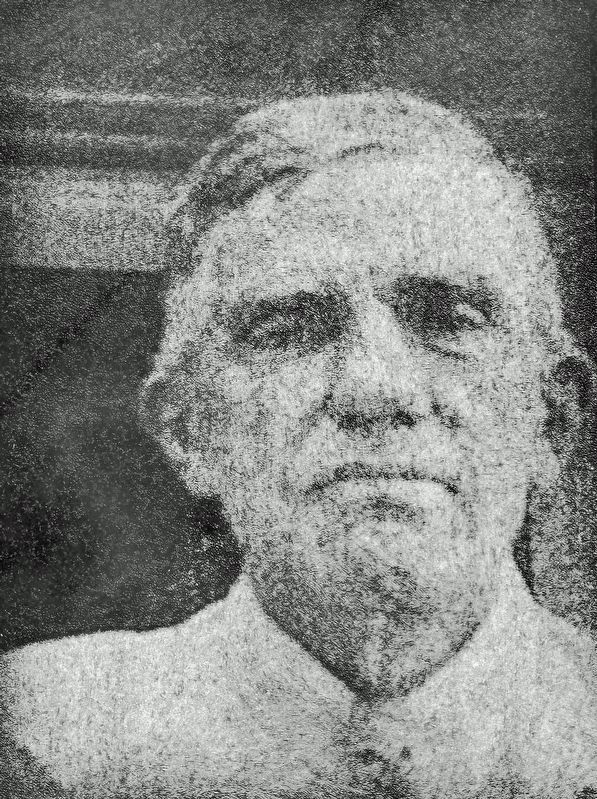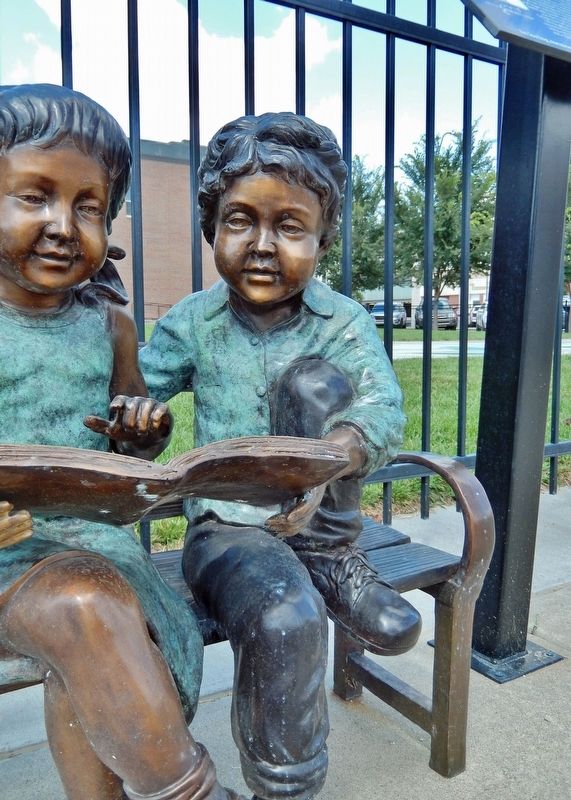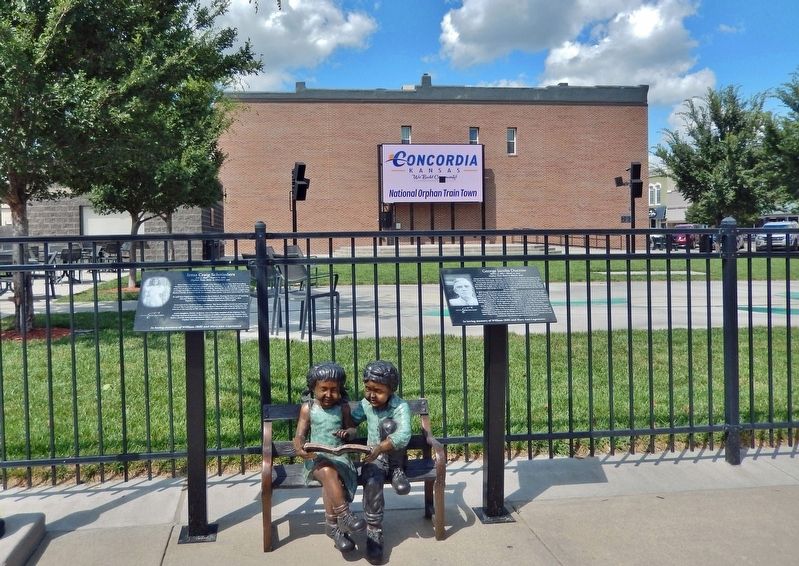Concordia in Cloud County, Kansas — The American Midwest (Upper Plains)
George Jacobs Ducrow
March 13, 1863 - March 13, 1944
— Orphan Train Rider to Illinois, 1878 —
George Jacobs Ducrow was born into a circus. His earliest memory was training with L.B. Lents New York circus. However, his time there was not all fun and games. In 1873 he was badly injured in a fireworks accident and was blind for three months. He eventually left the circus and was sent to live with his grandmother, who took him to New York City in 1876. A few months after their arrival, his grandmother died, leaving thirteen-year-old George on his own. He sought help and was taken to the New York Juvenile Asylum.
In 1878 George was placed out in Illinois with a farmer who was not kind to him. After four years he ran away and worked for a number of other farmers before he finally settled in Irving, Illinois, where he worked in a hardware store. In 1898 George enlisted and served in the Spanish American War. Following his service, he returned to Illinois and began working for the John Deere Plow Company as a traveling expert. He and his family later moved to Mississippi where George worked as a John Deere demonstrator, and then to St. Louis, Missouri, where he worked in the John Deere office.
George married Julia Dickerson, a widow and mother of one, and together they had two daughters. The family never missed a circus or a parade! His daughter Edith remembered her father as a loving parent, devoted Christian, and reader. "He enjoyed being with us and enjoyed all the things that he missed in his childhood with us… He was a 'flag waving American,' and never complained about the past. Instead, he loved America for… 'the chance it gave him to make good.'"
Erected by National Orphan Train Complex.
Topics. This historical marker is listed in these topic lists: Charity & Public Work • Industry & Commerce • Railroads & Streetcars • War, Spanish-American. A significant historical year for this entry is 1878.
Location. 39° 34.274′ N, 97° 39.567′ W. Marker is in Concordia, Kansas, in Cloud County. Marker is on Broadway Street just south of West 6th Street, on the right when traveling south. Marker and sculpture are located beside the sidewalk on the east side of Broadway Plaza. Touch for map. Marker is at or near this postal address: 600 Broadway Street, Concordia KS 66901, United States of America. Touch for directions.
Other nearby markers. At least 8 other markers are within walking distance of this marker. Irma Craig Schnieders (here, next to this marker); Miriam Malford Roering Zitur (within shouting distance of this marker); Michalena Birraglio / Lena Nelson (within shouting distance of this marker); Joseph Fuourka / Joseph "Joe" Roguet Aillet (within shouting distance of this marker); Elmer Barney Malone & Ethel Barney Malone Staley (within shouting distance of this marker); Rudolph Jubelt (within shouting distance of this marker); Cora Alice McVicker / Eugenia Alice Cullivan Mulligan (within shouting distance of this marker); In Memory of George C. Padgett (within shouting distance of this marker). Touch for a list and map of all markers in Concordia.
Related markers. Click here for a list of markers that are related to this marker. Orphan Train Movement
Also see . . .
1. George Jacobs Ducrow (Find A Grave).
George Ducrow spent his early years traveling in a circus with his father. After an injury prevented him from performing, his father left him. A grandmother took him in until her death, then he was sent to IL on an Orphan Train.(Submitted on December 18, 2022, by Cosmos Mariner of Cape Canaveral, Florida.)
2. A History of the Orphan Trains.
When the Orphan Train movement began, in the mid-19th century, it was estimated that approximately 30,000 abandoned children were living on the streets of New York. Over the 75 year span of the Orphan Train movement, it is estimated that between 150,000 and 200,000 children were relocated to new homes via the Orphan Trains.(Submitted on December 18, 2022, by Cosmos Mariner of Cape Canaveral, Florida.)
3. The Orphan Trains.
The story of this ambitious and finally controversial effort to rescue poor and homeless children begins in the 1850s, when thousands of children roamed the streets of New York in search of money, food and shelter — prey to disease and crime. Many sold matches, rags, or newspapers to survive.(Submitted on December 18, 2022, by Cosmos Mariner of Cape Canaveral, Florida.)
Credits. This page was last revised on December 24, 2022. It was originally submitted on December 17, 2022, by Cosmos Mariner of Cape Canaveral, Florida. This page has been viewed 94 times since then and 14 times this year. Photos: 1, 2, 3, 4. submitted on December 18, 2022, by Cosmos Mariner of Cape Canaveral, Florida.



